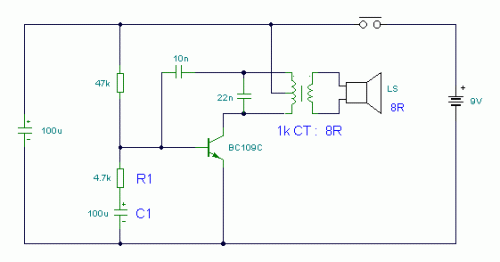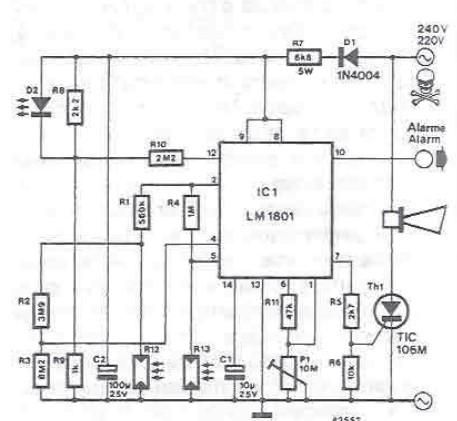
Simple Electronic Metronome

Metronome is an electronic device that keeps rhythm by making regulated clicking sounds, device used to keep the beat while playing a musical instrument. The circuit is an old design to build, but you will find it useful.
The metronome circuit typically consists of a few key components: a timer IC (such as the 555 timer), resistors, capacitors, a speaker or piezo buzzer, and a power supply. The 555 timer is configured in astable mode, generating a square wave output at a frequency determined by the values of the resistors and capacitors connected to it. This frequency corresponds to the desired beats per minute (BPM) for the metronome.
To construct the circuit, the following steps are generally followed:
1. **Power Supply**: The circuit is powered by a DC supply, usually between 5V and 15V, depending on the specifications of the timer IC and the output device.
2. **Timer Configuration**: The 555 timer is connected in astable mode. Two resistors (R1 and R2) and a capacitor (C1) are connected to the timer to set the frequency of oscillation. The frequency (f) can be calculated using the formula:
\[
f = \frac{1.44}{(R1 + 2R2) \cdot C1}
\]
Adjusting R1, R2, and C1 allows for modification of the tempo.
3. **Output Stage**: The output pin of the 555 timer is connected to a speaker or piezo buzzer. The output can be amplified with a transistor if needed, especially if a louder sound is desired.
4. **User Controls**: Additional controls can be incorporated, such as a potentiometer to allow for fine-tuning of the tempo, and a switch to turn the metronome on and off.
5. **Enclosure**: The circuit can be housed in a small enclosure with a user interface that includes a tempo display, control knobs, and an on/off switch.
This metronome circuit is not only a practical tool for musicians but also serves as an excellent project for those looking to understand basic electronic components and their interactions.Metronome is an electronic device that keeps rhythm by making regulated clicking sounds, device used to keep the beat while playing a musical instrument. The circuit is an old design to build, but you will find it useful. 🔗 External reference
The metronome circuit typically consists of a few key components: a timer IC (such as the 555 timer), resistors, capacitors, a speaker or piezo buzzer, and a power supply. The 555 timer is configured in astable mode, generating a square wave output at a frequency determined by the values of the resistors and capacitors connected to it. This frequency corresponds to the desired beats per minute (BPM) for the metronome.
To construct the circuit, the following steps are generally followed:
1. **Power Supply**: The circuit is powered by a DC supply, usually between 5V and 15V, depending on the specifications of the timer IC and the output device.
2. **Timer Configuration**: The 555 timer is connected in astable mode. Two resistors (R1 and R2) and a capacitor (C1) are connected to the timer to set the frequency of oscillation. The frequency (f) can be calculated using the formula:
\[
f = \frac{1.44}{(R1 + 2R2) \cdot C1}
\]
Adjusting R1, R2, and C1 allows for modification of the tempo.
3. **Output Stage**: The output pin of the 555 timer is connected to a speaker or piezo buzzer. The output can be amplified with a transistor if needed, especially if a louder sound is desired.
4. **User Controls**: Additional controls can be incorporated, such as a potentiometer to allow for fine-tuning of the tempo, and a switch to turn the metronome on and off.
5. **Enclosure**: The circuit can be housed in a small enclosure with a user interface that includes a tempo display, control knobs, and an on/off switch.
This metronome circuit is not only a practical tool for musicians but also serves as an excellent project for those looking to understand basic electronic components and their interactions.Metronome is an electronic device that keeps rhythm by making regulated clicking sounds, device used to keep the beat while playing a musical instrument. The circuit is an old design to build, but you will find it useful. 🔗 External reference





